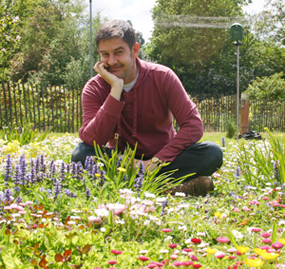Greener, prettier and more biodiverse: grass-free gardens for the next Millawnium
Release Date 17 May 2013

Want to make your lawn stand out with a sea of colour? Fancy cutting down on the mowing and helping the environment? These are some of the potential benefits you might see if you decide to go for a grass-free lawn, a University of Reading researcher has found.
Lionel Smith, a PhD researcher from the School of Biological Sciences, has been showcasing his pioneering research at the RHS Chelsea Flower Show this week, scooping a Silver Flora Award in the Environment Section.
The University's award-winning exhibit featured an impressive, highly-illustrated six metre wide display designed by Typography & Graphic Communication BA finalists Sarah Baines and Megan Harvey, which was made on campus by the University's Design & Print Studio.
For the last four years Lionel has been examining the potential for a ‘flowering lawn'. This has recently led to the creation of the world's first public grass-free lawn in Avondale Park, Notting Hill, London.
His research indicates that grass-free lawns are likely to perform best with no additional fertilizer and reduce the need for mowing by up to two thirds. They can also produce up to 90% more flowers and contain over 25% more invertebrate life in greater variety than that found in traditionally managed grass lawns.
Lionel suggests perennial forbs such as buttercups are a good start to a flowering lawn as they can be spread by runners, not just by seed. Other mowing tolerant species can be subsequently added including some species that are seen to be decreasing in the wild such as common milkwort.
Lionel said: "Grassy lawns have been with us for almost a millennium. A thousand years after the first record we have of grass lawns, we face new environmental challenges that grass-free lawns may go some way toward addressing. By removing grass from the lawn, gardeners will only need to use the mower for less than 10 days a year, saving energy and meaning less carbon dioxide is released into the atmosphere. They also don't need fertilizers, and offer nectar sources to pollinators.
"Although flowering lawns are not a replacement for hard wearing turf, they can withstand light footfall. As hard as it may seem, occasionally stepping on your flower lawn will help it stay low and well rooted; and to top it off these lawns can look absolutely stunning!"
Grass has been traditionally used in lawns because they quickly regrow if their leaves are eaten or cut by a mower.
"This gives them an advantage in environments that are regularly defoliated, such as lawns and pastures," continued Lionel. "They can out-compete both shorter and slower growing plants by quickly taking the available light and soil nutrients. By excluding grasses from the lawn, many other plant species that have different growth patterns and the potential to produce flowers, can be used in the same space."
Lionel says you don't have to be plant expert to create a grass-free lawn.
"A bit of horticultural knowledge on the behaviour of individual plant species is helpful when planting a new flower lawn. However a flowering lawn is a living garden feature and like most living garden features, a bit of gardening can usually resolve any issues that arise. "
A New Millawnium - Grass-free and full of flowers will be exhibited at Stand J5. Environment Section of the Grand Marquee, RHS Chelsea Flower Show 2013
